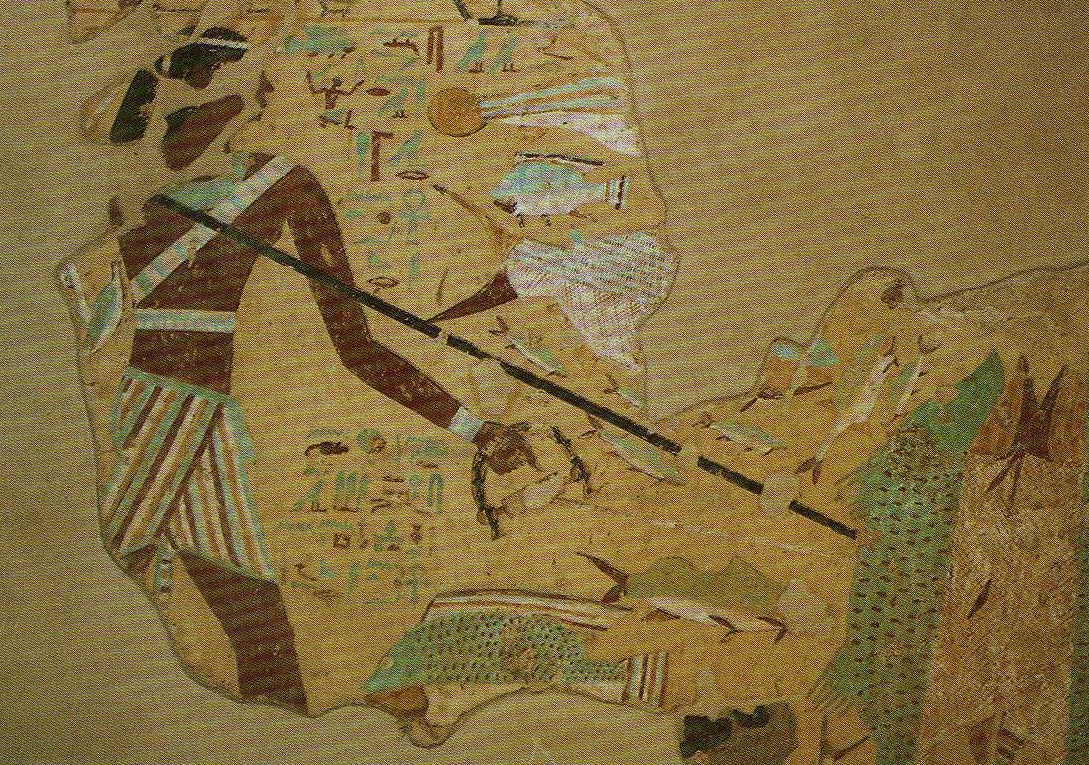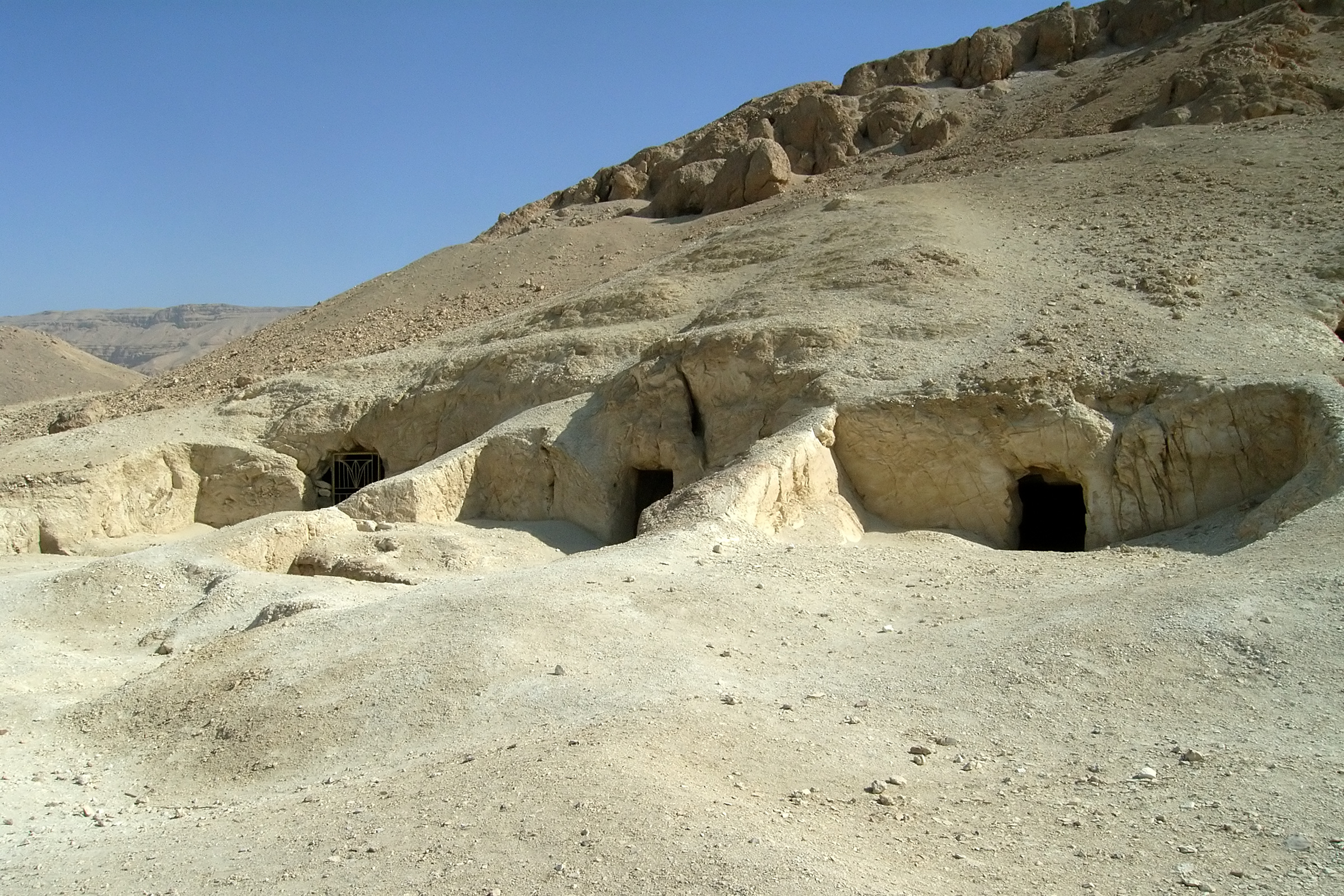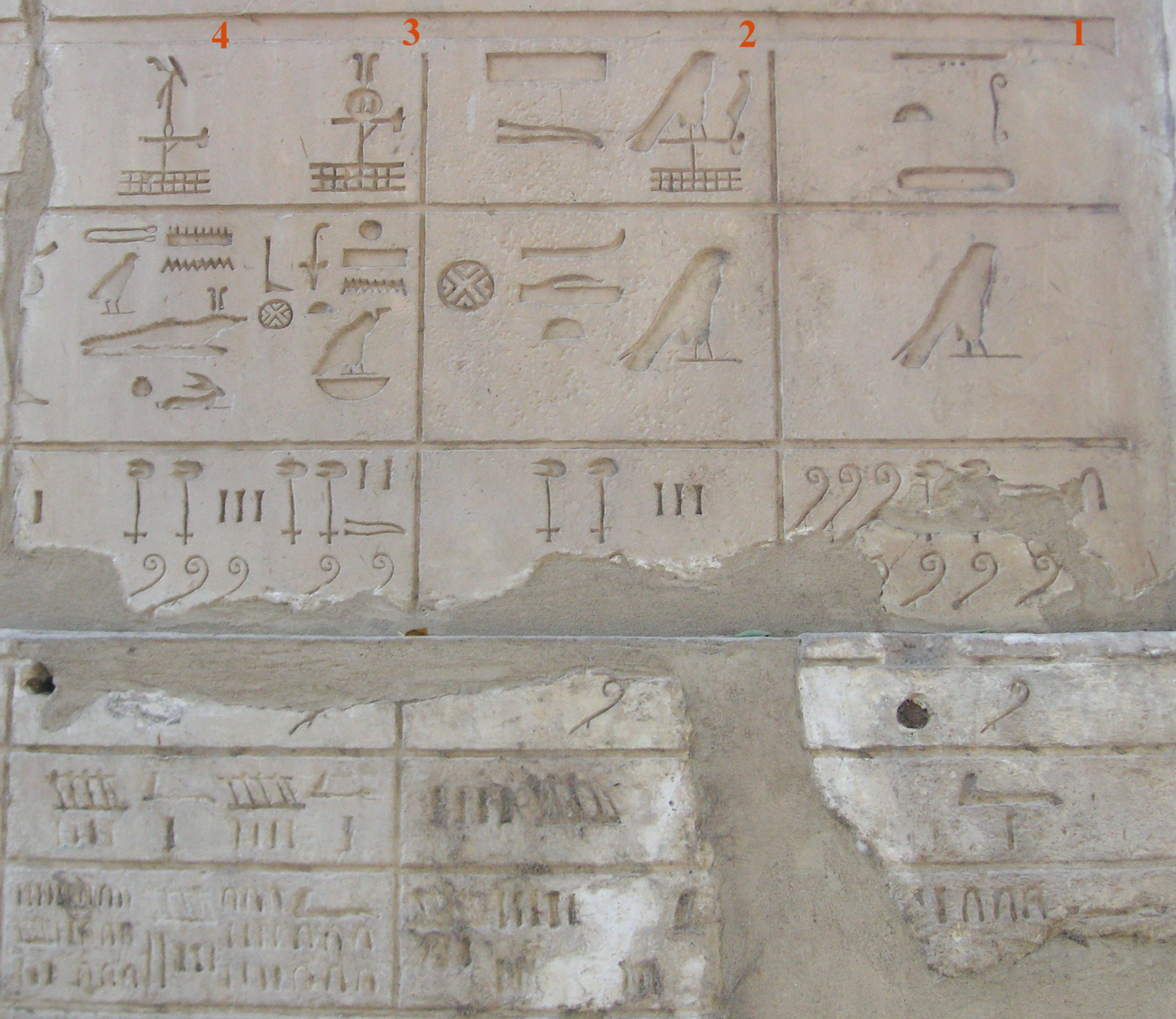|
Ankhtifi
Ankhtifi (or Ankhtify) was a nomarch of Hierakonpolis and a supporter of the pharaoh in Herakleopolis Magna (10th Dynasty), which was locked in a conflict with the Theban based 11th Dynasty kingdom for control of Egypt. Hence, Ankhtifi was possibly a rival to the Theban rulers Mentuhotep I and Intef I. He lived during the First Intermediate Period, after the Egyptian Old Kingdom state had collapsed, and at a time when economic hardship, political instability, and foreign invasion challenged the fabric of Egyptian society. Biography The precise pharaoh under whom Ankhtifi served is anything but certain; the sequence and number of kings in the 9th and 10th dynasties is a matter of widely varying conjecture. Only a few of the many names on the much later king-lists have had their reigns or existence corroborated through scattered archaeological finds. The only pharaoh mentioned in Ankhtifi's tomb is in the following isolated inscription: "Horus brings/brought (or may Horus bring) ... [...More Info...] [...Related Items...] OR: [Wikipedia] [Google] [Baidu] |
First Intermediate Period Of Egypt
The First Intermediate Period, described as a 'dark period' in ancient Egyptian history, spanned approximately 125 years, c. 2181–2055 BC, after the end of the Old Kingdom. It comprises the Seventh (although this is mostly considered spurious by Egyptologists), Eighth, Ninth, Tenth, and part of the Eleventh Dynasties. The concept of a "First Intermediate Period" was coined in 1926 by Egyptologists Georg Steindorff and Henri Frankfort. Very little monumental evidence survives from this period, especially from the beginning of the era. The First Intermediate Period was a dynamic time in which rule of Egypt was roughly equally divided between two competing power bases. One of the bases was at Heracleopolis in Lower Egypt, a city just south of the Faiyum region, and the other was at Thebes, in Upper Egypt. It is believed that during that time, temples were pillaged and violated, artwork was vandalized, and the statues of kings were broken or destroyed as a result of the ... [...More Info...] [...Related Items...] OR: [Wikipedia] [Google] [Baidu] |
Intef I
Sehertawy Intef I was a local nomarch at Thebes during the early First Intermediate Period and the first member of the 11th Dynasty to lay claim to a Horus name. Intef reigned from 4 to 16 years c. 2120 BC or c. 2070 BC during which time he probably waged war with his northern neighbor, the Coptite nomarch Tjauti. Intef was buried in a saff tomb at El-Tarif, known today as Saff el-Dawaba. Sources Intef is known for certain from only one near-contemporary monument: two inscribed blocks from the temple of Montu at Tod which were erected during Mentuhotep II's reign. The blocks represent Mentuhotep II facing the names of three of his ancestors which are identified by their proper name (nomen) and Horus name. These are Intef (I) Sehertawy, Intef (II) Wahankh and Intef (III) Nakht-neb-tep-nefer (although in this case only the Horus names Sehertawy and Wahankh are preserved). This relief establishes the succession of kings of the 11th Dynasty. There are no contemporary monum ... [...More Info...] [...Related Items...] OR: [Wikipedia] [Google] [Baidu] |
El-Mo'alla
El Mo'alla ( ar, المعلّى) is a town in Upper Egypt located about 35 km south of Luxor, on the east bank of the Nile. Known as Hefat by ancient Egyptians, it served as a necropolis for the nearby city of Djerty (nowadays El-Tod) since the early First Intermediate Period. Two rock-cut tombs within it, datable to this period, are particularly remarkable because of their decorations, that of the two nomarchs Ankhtifi Ankhtifi (or Ankhtify) was a nomarch of Hierakonpolis and a supporter of the pharaoh in Herakleopolis Magna (10th Dynasty), which was locked in a conflict with the Theban based 11th Dynasty kingdom for control of Egypt. Hence, Ankhtifi was poss ... and Sobekhotep. References External links Egyptsites page on el-Mo'alla Towns in Egypt Populated places in Luxor Governorate {{egypt-geo-stub ... [...More Info...] [...Related Items...] OR: [Wikipedia] [Google] [Baidu] |
Old Kingdom
In ancient Egyptian history, the Old Kingdom is the period spanning c. 2700–2200 BC. It is also known as the "Age of the Pyramids" or the "Age of the Pyramid Builders", as it encompasses the reigns of the great pyramid-builders of the Fourth Dynasty, such as King Sneferu, who perfected the art of pyramid-building, and the kings Khufu, Khafre and Menkaure, who constructed the pyramids at Giza. Egypt attained its first sustained peak of civilization during the Old Kingdom, the first of three so-called "Kingdom" periods (followed by the Middle Kingdom and New Kingdom), which mark the high points of civilization in the lower Nile Valley. The concept of an "Old Kingdom" as one of three "golden ages" was coined in 1845 by the German Egyptologist Baron von Bunsen, and its definition would evolve significantly throughout the 19th and the 20th centuries. Not only was the last king of the Early Dynastic Period related to the first two kings of the Old Kingdom, but the "capital ... [...More Info...] [...Related Items...] OR: [Wikipedia] [Google] [Baidu] |
Tenth Dynasty Of Egypt
The Tenth Dynasty of ancient Egypt (Dynasty X) is often combined with the 7th, 8th, 9th and early 11th Dynasties under the group title First Intermediate Period. Rulers The 9th Dynasty was founded at Herakleopolis Magna, and the 10th Dynasty continued there. At this time Egypt was not unified, and there is some overlap between these and other local dynasties. The Turin Canon lists eighteen kings for this royal line, but their names are damaged, unidentifiable, or lost.Sir Alan Gardiner Sir Alan Henderson Gardiner, (29 March 1879 – 19 December 1963) was an English Egyptologist, linguist, philologist, and independent scholar. He is regarded as one of the premier Egyptologists of the early and mid-20th century. Personal life ..., ''Egypt of the Pharaohs'', Oxford University Press, 1961, pp. 112-13. The following is a ''possible'' list of rulers of the Tenth Dynasty based on the Turin Canon, as Egyptologists have differing opinions about the order of succession within t ... [...More Info...] [...Related Items...] OR: [Wikipedia] [Google] [Baidu] |
10th Dynasty
The Tenth Dynasty of ancient Egypt (Dynasty X) is often combined with the Seventh Dynasty of Egypt, 7th, Eighth Dynasty of Egypt, 8th, Ninth Dynasty of Egypt, 9th and early Eleventh Dynasty of Egypt, 11th Dynasties under the group title First Intermediate Period. Rulers The 9th Dynasty was founded at Herakleopolis Magna, and the 10th Dynasty continued there. At this time Egypt was not unified, and there is some overlap between these and other local dynasties. The Turin Canon lists eighteen kings for this royal line, but their names are damaged, unidentifiable, or lost.Sir Alan Gardiner, ''Egypt of the Pharaohs'', Oxford University Press, 1961, pp. 112-13. The following is a ''possible'' list of rulers of the Tenth Dynasty based on the Turin Canon, as Egyptologists have differing opinions about the order of succession within the two dynasties. Among them, only Wahkare Khety and Merykare are undoubtedly attested by archaeological finds: References Tenth Dynast ... [...More Info...] [...Related Items...] OR: [Wikipedia] [Google] [Baidu] |
Old Kingdom Of Egypt
In ancient Egyptian history, the Old Kingdom is the period spanning c. 2700–2200 BC. It is also known as the "Age of the Pyramids" or the "Age of the Pyramid Builders", as it encompasses the reigns of the great pyramid-builders of the Fourth Dynasty, such as King Sneferu, who perfected the art of pyramid-building, and the kings Khufu, Khafre and Menkaure, who constructed the pyramids at Giza. Egypt attained its first sustained peak of civilization during the Old Kingdom, the first of three so-called "Kingdom" periods (followed by the Middle Kingdom and New Kingdom), which mark the high points of civilization in the lower Nile Valley. The concept of an "Old Kingdom" as one of three "golden ages" was coined in 1845 by the German Egyptologist Baron von Bunsen, and its definition would evolve significantly throughout the 19th and the 20th centuries. Not only was the last king of the Early Dynastic Period related to the first two kings of the Old Kingdom, but the "capi ... [...More Info...] [...Related Items...] OR: [Wikipedia] [Google] [Baidu] |
Intef II
Wahankh Intef II (also Inyotef II and Antef II) was the third ruler of the Eleventh Dynasty of Egypt during the First Intermediate Period. He reigned for almost fifty years from 2112 BC to 2063 BC. His capital was located at Thebes. In his time, Egypt was split between several local dynasties. He was buried in a saff tomb at El-Tarif. Family Intef's parents were Mentuhotep I and Neferu I. His predecessor Intef I may have been his brother. Intef was succeeded by his son Intef III. Reign After the death of the nomarch Ankhtifi, Intef was able to unite all the southern nomes down to the First Cataract. After this he clashed with his main rivals, the kings of Herakleopolis Magna for the possession of Abydos. The city changed hands several times, but Intef II was eventually victorious, extending his rule north to the thirteenth nome. After these wars, more friendly relations were established and the rest of Intef's reign was peaceful. The discovery of a statue of Intef II, ... [...More Info...] [...Related Items...] OR: [Wikipedia] [Google] [Baidu] |
Nekhen (nome)
Nekhen was the name of the third Upper Egyptian nome (province). Nekhen is also the Egyptian name of Hierakonpolis, one of the main towns in the province. During the Ptolemaic Greek and Roman eras, the province was called Latopolites, for Esna was in this period the main town and its Greek name was ''Latopolis'' or ''Letopolis''. The main towns in the province were Nekhen, Elkab and Esna. The province is already mentioned in inscriptions of the Old Kingdom In ancient Egyptian history, the Old Kingdom is the period spanning c. 2700–2200 BC. It is also known as the "Age of the Pyramids" or the "Age of the Pyramid Builders", as it encompasses the reigns of the great pyramid-builders of the Fourth ....Farouk Gomaa, ''Die Besiedlung Ägyptens während des Mittleren Reiches, 1. Oberägypten und das Fayyum'', Reichert, Wiesbaden 1986, , p. 51-88 References {{DEFAULTSORT:Nekhen Nomes of ancient Egypt ... [...More Info...] [...Related Items...] OR: [Wikipedia] [Google] [Baidu] |
Weni The Elder
The Autobiography of Weni is a tomb inscription from ancient Egypt, which is significant to Egyptology studies. Weni the Elder, or Uni, was a court official of the 6th Dynasty of Ancient Egypt. The Tomb of Weni was lost as a result of Auguste Mariette's 1880 description of Weni's tomb being unclear (" nthe high hill which gives the middle cemetery its name"). It was rediscovered in 1999 by an American archaeologist team led by Dr. Janet Richards. More recent works in the necropolis of Pepi I in Saqqara uncovered a second tomb for Weni with a near-identical copy of his biography. Biography Weni began his career under Teti, and rose through the ranks of the administration under Pepi I Meryre, for whom he was in turn a judge, a general and a vizier. Later, Weni became the governor of Upper Egypt during the reign of Merenre Nemtyemsaf I. As judge he investigated the queen who was apparently suspected of involvement in a conspiracy. While he was general, he reorganized the militar ... [...More Info...] [...Related Items...] OR: [Wikipedia] [Google] [Baidu] |
6th Dynasty
The Sixth Dynasty of ancient Egypt (notated Dynasty VI), along with the Third, Fourth and Fifth Dynasty, constitutes the Old Kingdom of Dynastic Egypt. Pharaohs Known pharaohs of the Sixth Dynasty are listed in the table below. Manetho accords the dynasty 203 regnal years from Teti to Nitocris, while the Turin Canon assigns 181 regnal years, but with three additional kings concluding with Aba – discounting the reigns of the added Eighth Dynasty kings, this is reduced to 155 regnal years. This estimate varies between both scholar and source. History The Sixth Dynasty is considered by many authorities as the last dynasty of the Old Kingdom, although ''The Oxford History of Ancient Egypt'' includes Dynasties VII and VIII as part of the Old Kingdom. Manetho writes that these kings ruled from Memphis, since their pyramids were built at Saqqara, very close one to another. By the Fifth Dynasty, the religious institution had established itself as the domin ... [...More Info...] [...Related Items...] OR: [Wikipedia] [Google] [Baidu] |
Tomb Of Anchtifi 02
A tomb ( grc-gre, τύμβος ''tumbos'') is a repository for the remains of the dead. It is generally any structurally enclosed interment space or burial chamber, of varying sizes. Placing a corpse into a tomb can be called ''immurement'', and is a method of final disposition, as an alternative to cremation or burial. Overview The word is used in a broad sense to encompass a number of such types of places of interment or, occasionally, burial, including: * Architectural shrines – in Christianity, an architectural shrine above a saint's first place of burial, as opposed to a similar shrine on which stands a reliquary or feretory into which the saint's remains have been transferred * Burial vault – a stone or brick-lined underground space for multiple burials, originally vaulted, often privately owned for specific family groups; usually beneath a religious building such as a church ** Cemetery ** Churchyard * Catacombs * Chamber tomb * Charnel house * Chur ... [...More Info...] [...Related Items...] OR: [Wikipedia] [Google] [Baidu] |











